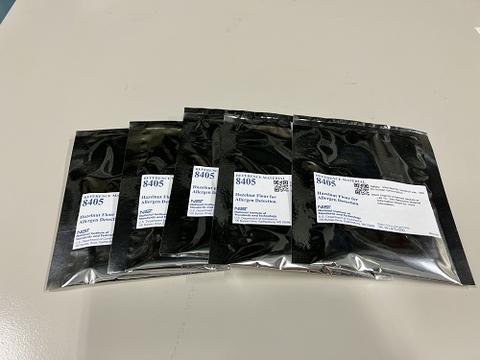
Food allergies affect millions of Americans every year. Though medications can treat allergy symptoms, preventative measures such as accurate food labeling and stopping cross-contact with potential allergens during food preparation can help ensure people are not exposed to foods that might cause an allergic reaction.
To support these preventative measures, researchers from the National Institute of Standards and Technology (NIST) have developed tree nut reference materials — hazelnut and almond flours — that will help ensure accurate and consistent results for test kits that regulators and food manufacturers can use to detect tree nut allergens.
“The main purpose of these test kits is to ensure that a food product hasn't unintentionally come into contact with allergens while it was being made,” said NIST chemist Melissa Phillips. In contrast with the more advanced regulatory tools for wheat and gluten, “there isn’t a test to say if something is hazelnut free,” she said. “Promoting awareness of cross-contact is the perspective we’re coming from with these reference materials.”
The U.S. Food and Drug Administration (FDA) regulates and provides guidance on assessing and managing allergens in food. Currently, the FDA recognizes eight food allergens: milk, eggs, fish, shellfish, soybeans, wheat, peanuts and tree nuts. A law was signed last year that declared sesame as the ninth food allergen, but the addition will not become effective until the beginning of 2023.
Tree nut allergies affect an estimated 0.5% to 1% of the total U.S population. As the name implies, tree nuts come from trees that produce walnuts, hazelnuts, almonds, pistachios, pecans, cashews, Brazil nuts and other common nuts.
Symptoms of tree nut or other food allergies can range from mild, such as breaking out in hives, to severe, including sudden drops in blood pressure, breathing difficulties and even death. The root causes of food allergies are often unknown, but the allergic reaction itself is caused when the body’s immune system responds to proteins in that food.

NIST’s Food Protein Allergen Program crafted the first tree nut reference materials with numerous end users in mind, ranging from individual food scientists and test kit manufacturers to entire research organizations such as the Association of Official Analytical Collaboration (AOAC) International, which hosts a Gluten and Food Allergens Program for many different groups, some of which provided input and feedback on these reference materials. “The reference materials support agreement of results within the food allergen community for tree nut detection,” said NIST chemist Ashley Beasley Green.
Current food packaging typically includes statements such as “contains milk” or “contains nut products” instead of listing how much of an allergen protein is present. To take the reporting of food allergens to the next level, the NIST program aims to support measurements of how much of a specific allergen protein is present, for example X amount of a specific almond protein. Knowing which specific proteins are present in a food can help physicians better understand and diagnose food allergies.
With the instruments and standards available now, determining the total amount of proteins by measuring each individual protein would be prohibitively time-consuming and expensive, so NIST researchers took an indirect approach that provided reasonable levels of accuracy. They worked with collaborators to measure the mass fraction of nitrogen atoms in the sample, which relates to how much of the hazelnut or almond proteins are in the sample. Researchers also confirmed that all of the proteins were from a single food source, and there was no cross-contact. Among other uses, the materials could help test kit manufacturers measure the total number of hazelnut and almond protein allergens in different food products and even compare their amounts.
Each reference material consists of a small pouch of five grams of the almond or hazelnut flour, with five pouches in a box. To produce them, researchers bought almond and hazelnut flour from different local stores and then tested it to ensure it did not have cross-contact with other tree nuts or contain other common allergens such as peanut and soy, said NIST chemist David Bunk.
Such cross-contact can frequently occur during the harvesting of tree nuts and at production plants through the use of shared equipment. For example, farmers could use the same agricultural equipment to harvest hazelnuts as they would pistachios, or a manufacturer could fail to properly clean equipment between making different types of flour.
The researchers worked with a company to properly package the reference material without creating additional risks of cross-contact. They then sent the materials to test kit developers who conducted their own tests on the reference materials, compared their results against a NIST-provided analysis, and provided feedback on their results and the tests they used. This feedback process helped NIST validate its own process and ensure the quality of the final product.
RM 8404 Almond Flour for Allergen Detection and RM 8405 Hazelnut Flour for Allergen Detection are available at NIST. Organizations wishing to purchase the reference materials can visit the NIST Standard Reference Materials page.

